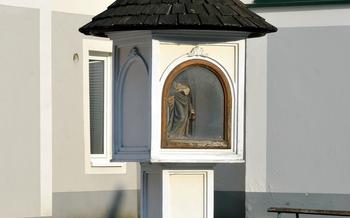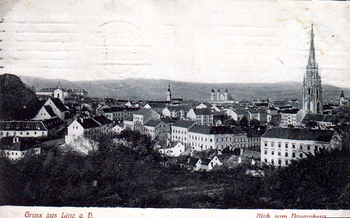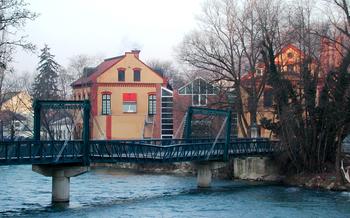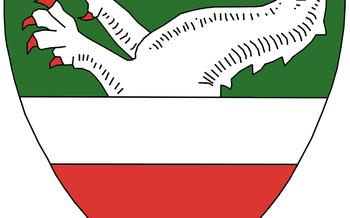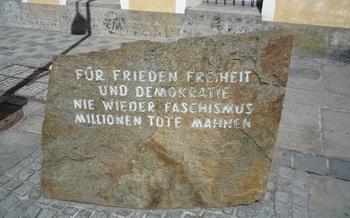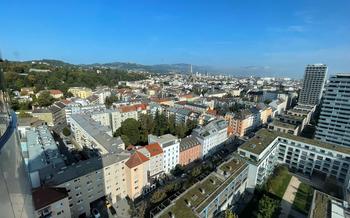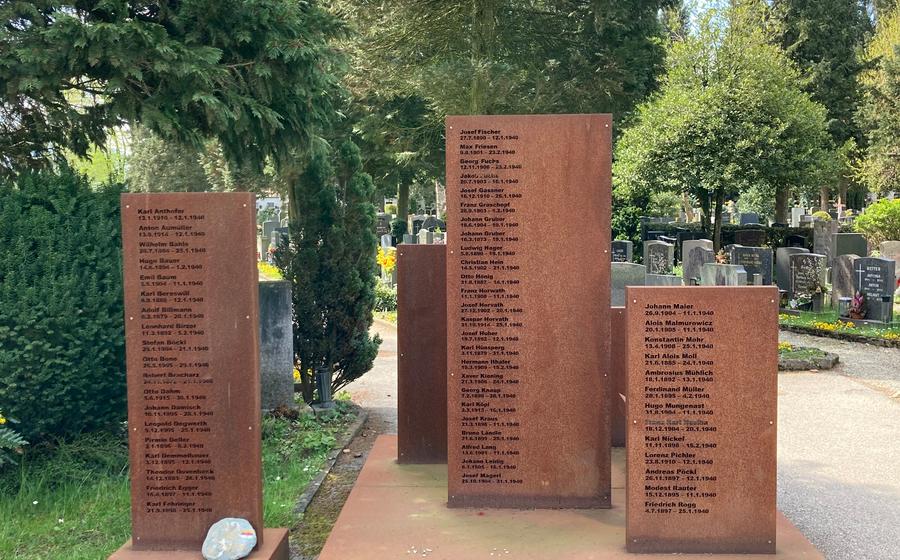
Mauthausen Memorial
- Navigating the Mauthausen Memorial Grounds
- Layout and Key Areas
- Accessibility and Visitor Facilities
- Guided Tours and Self-Guided Exploration
- Recommended Duration for a Visit
- Honoring the Victims: The Memorial Wall and Crematorium
- Reflecting at the Museum and Visitor Center
- Paying Respects at the International Monument
- Immersive Art Installations: The Stones of Remembrance
- The Mauthausen Memorial Archives: Preserving History
- Commemorative Events and Ceremonies
- Educational Programs and Workshops
- Volunteer and Internship Opportunities
- Local Perspectives: Engaging with the Steyr Community
- Ethical Considerations and Respectful Behavior
- Insider Tip: Discovering Hidden Gems in Steyr
Navigating the Mauthausen Memorial Grounds
The Mauthausen Memorial site encompasses a vast area, including the former camp grounds, quarry, and gas chamber. Visitors can explore the site independently or join a guided tour for a more in-depth experience.
Layout and Key Areas
The memorial grounds are divided into several key areas, each with its own significance. The main entrance leads to the visitor center, which houses exhibits, a museum shop, and a cafe. From there, visitors can follow paths that lead to the various memorial sites and historical landmarks.
Accessibility and Visitor Facilities
The memorial site is wheelchair accessible, with ramps and elevators providing access to all areas. Restrooms, drinking fountains, and seating areas are available throughout the grounds. Visitors can also rent audio guides or download a mobile app for self-guided tours.
Guided Tours and Self-Guided Exploration
Guided tours are offered daily in several languages and provide a comprehensive overview of the memorial site. Visitors can also choose to explore the grounds at their own pace using the self-guided tour option. Information panels and signs are placed throughout the site, providing historical context and details about the camp's operations.
Recommended Duration for a Visit
Allow at least three to four hours to fully explore the Mauthausen Memorial site. This will give you enough time to visit the museum, walk through the grounds, and take in the various memorial sites. If you are short on time, focus on the main areas, such as the visitor center, memorial wall, and quarry.
Honoring the Victims: The Memorial Wall and Crematorium
The Memorial Wall at the Mauthausen Memorial is a solemn and poignant tribute to the countless individuals who lost their lives within the camp's walls. Each name etched onto the wall represents a unique story of suffering, resilience, and loss. Visitors can spend hours tracing their fingers across the seemingly endless rows of names, contemplating the lives that were cut short during the Holocaust.
The crematorium, located adjacent to the memorial wall, stands as a chilling reminder of the systematic extermination that took place at Mauthausen. This haunting structure, once used to incinerate the bodies of deceased prisoners, now serves as a powerful symbol of the camp's dark history. Its presence evokes a profound sense of sorrow and reflection, urging visitors to confront the horrors of the past.
The stories behind the names on the memorial wall and the history of the crematorium offer a glimpse into the unimaginable suffering endured by the prisoners of Mauthausen. The weight of these stories can be overwhelming, yet they serve as a vital reminder of the atrocities that occurred and the importance of never forgetting the victims.
Reflecting at the Museum and Visitor Center
The Mauthausen Memorial Museum and Visitor Center serves as a central hub for education and remembrance, providing visitors with a deeper understanding of the camp's history and the experiences of its victims. Through a combination of exhibits, artifacts, and interactive elements, the museum sheds light on the atrocities committed during the Holocaust.
Exhibits at the museum delve into various aspects of camp life, including the daily routines, forced labor, and inhumane conditions endured by prisoners. Artifacts on display range from personal belongings and uniforms to tools used in the quarry and gas chamber. These tangible remnants of the past offer a glimpse into the lives of those who suffered within the camp's walls.
Interactive displays and multimedia presentations enhance the visitor experience, allowing them to engage with the history of Mauthausen in a meaningful way. Through touchscreens, audio recordings, and video testimonies, visitors can learn about the individual stories of prisoners, their struggles, and their resilience. The museum also features a research library and documentation center, providing access to archival materials for scholars and researchers.
By combining historical facts, personal narratives, and interactive elements, the Mauthausen Memorial Museum and Visitor Center creates a powerful learning environment that encourages visitors to confront the dark past and reflect on the consequences of intolerance and hatred. It serves as a reminder of the importance of remembrance, reconciliation, and the fight against all forms of human rights abuses.
Paying Respects at the International Monument
The International Monument, standing tall amidst the grounds of the Mauthausen Memorial, is a powerful symbol of remembrance and reconciliation. Erected in 1965, the monument embodies the collective grief and solidarity of nations whose citizens perished within the camp's walls.
Designed by the Austrian artist Alfred Hrdlicka, the monument comprises a series of bronze sculptures, each representing a different country that suffered losses at Mauthausen. The sculptures, bearing the names of the deceased, stand together in a circle, symbolizing unity in the face of tragedy.
Visitors to the memorial are often moved by the sight of this poignant tribute. The monument serves as a reminder of the devastating impact of the Holocaust on countless families and communities, and it underscores the importance of fostering peace and understanding among nations.
The multinational representation at the International Monument is particularly significant. By including sculptures from various countries, the monument acknowledges the shared suffering of all those who were persecuted and lost their lives during the Holocaust. It stands as a testament to the resilience and strength of the human spirit, even in the darkest of times.
The messages of peace and reconciliation conveyed by the monument resonate deeply with visitors. It is a place where people from all over the world can come together to pay their respects, reflect on the past, and pledge to work towards a future free from hatred and intolerance.
For many visitors, the International Monument is a powerful reminder of the fragility of peace and the importance of standing up against tyranny and oppression. It is a place where they can honor the victims of the Holocaust and reaffirm their commitment to building a more just and compassionate world.
Immersive Art Installations: The Stones of Remembrance
Amidst the somber landscape of the Mauthausen Memorial, visitors encounter a poignant and powerful art installation known as the Stones of Remembrance. Created by British artist Rachel Whiteread, this haunting artwork consists of 100 cast concrete blocks arranged in a grid formation, each representing a barrack that once stood within the camp.
The stones, varying in size and shape, evoke a sense of absence and loss, symbolizing the countless lives extinguished within the camp's walls. Each block bears the imprint of a door, a haunting reminder of the individual stories and tragedies that unfolded behind those doors.
Visitors are invited to walk among the stones, tracing the outlines of the doorways and contemplating the lives that were lived and lost within these barracks. The emotional impact is palpable, as the artwork encourages a profound connection with the past and the individuals who suffered here.
The Stones of Remembrance stand as a powerful testament to the horrors of the Holocaust and the enduring legacy of the Mauthausen Concentration Camp. Through this immersive art installation, visitors are invited to reflect on the immense suffering that took place within these grounds and to honor the memory of those who perished.
The Mauthausen Memorial Archives: Preserving History
The Mauthausen Memorial Archives serve as a vital repository for preserving and safeguarding historical records related to the camp. These archives house an extensive collection of documents, photographs, artifacts, and personal accounts that provide invaluable insights into the atrocities committed during the Holocaust. The meticulous preservation of these records ensures that the memory of the victims is honored, and their stories are not forgotten.
The archives play a crucial role in supporting research and education initiatives related to the Holocaust. Researchers and scholars have access to a wealth of primary source material, enabling them to conduct in-depth studies on various aspects of the camp's history, the experiences of the prisoners, and the broader context of the Nazi regime. Through these research endeavors, new knowledge and understanding are continuously generated, contributing to a more comprehensive understanding of this dark chapter in human history.
Visitors to the memorial site can also access the archives to gain a deeper understanding of the camp's history. Guided tours and educational programs often incorporate archival materials, allowing visitors to connect with the personal stories of the victims and gain a firsthand glimpse into the horrors they endured. By preserving these records and making them accessible, the Mauthausen Memorial Archives serve as a powerful tool for education and remembrance, fostering a greater awareness of the past and its lessons for the present.
Commemorative Events and Ceremonies
The Mauthausen Memorial site hosts annual remembrance ceremonies to honor the victims of the concentration camp and commemorate their suffering. These solemn events take place on specific dates throughout the year, often coinciding with significant anniversaries related to the camp's history.
During these ceremonies, survivors, family members, dignitaries, and representatives from various organizations gather to pay their respects and share their memories. Speeches, readings, and musical performances are often incorporated into the program, creating a poignant and moving atmosphere.
Special events and exhibitions are also organized throughout the year to raise awareness about the history of the camp and its impact on the local community and beyond. These events may include film screenings, lectures by historians and researchers, workshops, and educational programs.
The participation of survivors, families, and dignitaries in these events adds a deeply personal dimension to the commemorations. Their stories, testimonies, and reflections offer visitors a powerful reminder of the human toll of the Holocaust and the importance of remembering and learning from the past.
These events serve as a vital platform for keeping the memory of the victims alive, promoting understanding and reconciliation, and fostering a commitment to preventing future atrocities.
Educational Programs and Workshops
The Mauthausen Memorial is dedicated to educating visitors about the history of the camp, the Holocaust, and its broader implications. To this end, the memorial offers a range of educational programs and workshops that cater to different age groups and interests.
For schools and youth groups, the memorial offers guided tours tailored to their specific needs, emphasizing the historical context of the camp and the experiences of the prisoners. These tours are designed to encourage critical thinking, foster empathy, and promote human rights education.
Additionally, the memorial organizes workshops on Holocaust education and remembrance for educators and guides. These workshops provide participants with the knowledge and skills necessary to effectively teach about the Holocaust and its relevance to contemporary society.
The memorial also hosts regular events and exhibitions that focus on specific aspects of the camp's history or related topics. These events often feature presentations by historians, survivors, and other experts, providing visitors with a deeper understanding of the Holocaust and its lasting impact.
Through these educational initiatives, the Mauthausen Memorial strives to promote understanding, prevent intolerance, and ensure that the memory of the victims is never forgotten.
Volunteer and Internship Opportunities
The Mauthausen Memorial offers a range of volunteer and internship opportunities for individuals passionate about Holocaust remembrance and education. By participating in these programs, you can contribute to the preservation of history, promote understanding, and honor the victims of the camp.
Volunteer Opportunities
As a volunteer, you can play a vital role in supporting the memorial's mission. Volunteer positions are available in various areas, including visitor services, education programs, archival research, and administrative tasks. You will have the chance to interact with visitors from around the world, share your knowledge about the camp's history, and contribute to the overall functioning of the memorial.
Internship Programs
The Mauthausen Memorial also offers internship programs for students and professionals interested in gaining hands-on experience in Holocaust education and remembrance. Interns work closely with memorial staff on various projects, such as research, educational materials development, and event planning. These internships provide a unique opportunity to learn from experts in the field and make a meaningful contribution to the memorial's work.
Benefits of Volunteering and Interning
Volunteering or interning at the Mauthausen Memorial is a rewarding and enriching experience. You will gain valuable knowledge about the Holocaust, develop your skills in education and outreach, and have the chance to make a positive impact on visitors' understanding of this dark chapter in history. You will also become part of a dedicated team committed to preserving the memory of the victims and promoting peace and reconciliation.
To learn more about volunteer and internship opportunities at the Mauthausen Memorial, visit the memorial's website or contact the education department directly.
Local Perspectives: Engaging with the Steyr Community
Beyond the memorial site, visitors can engage with the local community of Steyr to gain a deeper understanding of the camp's history and its impact on the region. Interacting with local residents and historians provides insights into the local perspective on the events that transpired during the war. Many residents have personal connections to the camp, either through family members who were imprisoned or through local knowledge passed down through generations.
Engaging with the Steyr community offers a chance to explore the town's efforts to confront its past. Steyr has actively worked to acknowledge and commemorate the victims of the camp, including initiatives such as the establishment of the Mauthausen Memorial and educational programs for local schools. Visitors can learn about these efforts and gain a deeper appreciation for the town's commitment to remembrance and reconciliation.
Building bridges of understanding between visitors and the local community is an important aspect of the Mauthausen Memorial experience. By interacting with residents, visitors can gain a more nuanced understanding of the camp's history and its lasting impact on the region. These interactions promote empathy, foster dialogue, and contribute to a collective effort to prevent future atrocities.
Ethical Considerations and Respectful Behavior
When visiting the Mauthausen Memorial, it is crucial to approach the site with respect and sensitivity. The memorial is a place of remembrance and contemplation, dedicated to honoring the victims and their families. Visitors should conduct themselves in a manner that is appropriate for such a solemn environment.
- Guidelines for Respectful Conduct:
- Avoid loud conversations, laughter, or any behavior that may disturb the contemplative atmosphere of the memorial.
- Refrain from using flash photography or taking selfies at inappropriate locations within the memorial grounds.
- Respect the privacy of other visitors who may be seeking a quiet and reflective experience.
-
Be mindful of the emotional impact of the site and refrain from making insensitive or disrespectful comments.
-
Appropriate Behavior and Language:
- Use respectful language when discussing the history of the camp and the experiences of the prisoners.
- Avoid using derogatory or offensive terms that may be hurtful to survivors or their families.
-
Refrain from glorifying or trivializing the atrocities that occurred at Mauthausen.
-
Maintaining a Contemplative Atmosphere:
- Take time to pause, reflect, and absorb the significance of the memorial.
- Allow yourself to be moved by the stories of the victims and their resilience.
- Embrace the opportunity for personal reflection and growth.
By following these guidelines, visitors can contribute to preserving the dignity of the victims and their families and ensure that the memorial remains a place of remembrance and peace.
Insider Tip: Discovering Hidden Gems in Steyr
While visiting the Mauthausen Memorial, take the opportunity to explore the captivating city of Steyr. Begin your journey in the heart of the Old Town, where cobblestone streets wind past pastel-colored buildings, creating a picturesque ambiance. Admire the intricate details of the Town Hall, a 17th-century architectural masterpiece, and wander through the charming squares, each with its own unique character.
Ascend to the Steyr Castle, perched on a hill overlooking the city. Immerse yourself in the rich history of this 10th-century fortress, once the seat of powerful rulers. From the castle ramparts, enjoy breathtaking panoramic views of the Steyr River and the surrounding Alpine landscapes.
Indulge in the local cuisine at one of the many traditional restaurants, savoring regional delicacies such as "Knödel" (dumplings) and "Schnitzel" (breaded cutlets). Immerse yourself in the vibrant cafe culture, sipping on a frothy "Melange" (coffee with milk) while observing the lively atmosphere.
Uncover the unique heritage of Steyr at the Knife Museum, a fascinating repository of cutlery and bladed instruments from around the world. Marvel at the intricate craftsmanship of these objects, which have played a significant role in the city's industrial history.
Venture beyond the city center to discover hidden gems such as the Steyr Water Park, a picturesque oasis with lush greenery and serene waterways. Embark on a leisurely hike along the Steyr River Trail, immersing yourself in the tranquility of nature and capturing stunning views of the river and its surroundings.
Steyr's rich history, vibrant culture, and natural beauty offer a compelling complement to your visit to the Mauthausen Memorial. Take the time to explore this captivating city and gain a deeper appreciation for the region's past and present.


